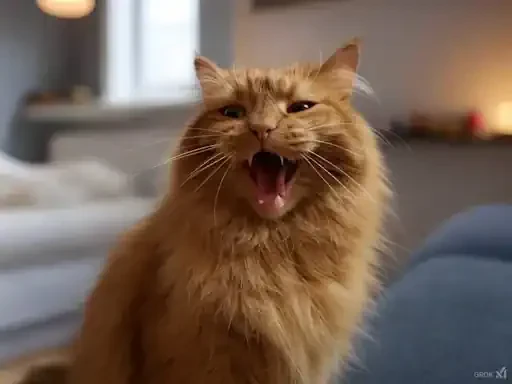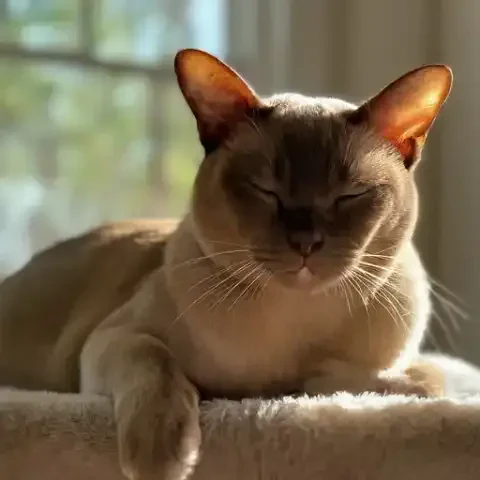A familiar sound fills the air – a plaintive cry, a demanding yowl, a soft murmur. It’s the sound of a cat, communicating, seemingly in its most basic way. We might interpret it simply as a “meow,” a generic feline utterance, easily dismissed as instinct or a straightforward demand for food or attention. But is it really just a meow? Scratch beneath the surface of feline vocalizations and behaviors, and a far more intricate and fascinating world of communication emerges, a world that challenges our often human-centric and simplistic views of animal language. For too long, we’ve approached animal communication, particularly that of creatures unlike ourselves, through a lens that prioritizes human language as the gold standard. We’ve relegated animal signals to the realm of instinct, dismissing them as rudimentary and unsophisticated, especially compared to the complex structures of human speech. However, when we turn our attention to the domestic cat, a creature often perceived as enigmatic and independent, we begin to uncover a communication system that is far richer and more nuanced than we typically give it credit for. This exploration aims to move beyond this anthropocentric bias and delve into the world of feline communication as a structured, multifaceted system, akin to a language in its own right. We’ll employ a “linguistic exploration,” not in the strict sense of human linguistics, but in the broader sense of understanding feline communication as a complex system with its own grammar, lexicon, and pragmatics. This means examining not just their vocalizations, but also the intricate syntax of their body language, the rich olfactory dictionary of scents, and the subtle tactile cues that together create a comprehensive and versatile means of conveying information. We will argue that feline communication is a sophisticated and multifaceted system, encompassing a wide array of signals that work in concert to express a complex range of emotions, intentions, and social nuances, deserving of a deep and respectful linguistic exploration. Through this exploration, we hope to not only decode the "cat's meow" in all its forms but also to foster a deeper appreciation for the communicative intelligence of these often misunderstood creatures.
When we think of feline vocalizations, the “meow” immediately comes to mind. It’s the quintessential cat sound, seemingly simple and readily identifiable. Yet, to assume that the meow is a single, monolithic sound is to vastly underestimate the complexity of feline vocal communication. In reality, the meow is far from generic; it’s remarkably variable and context-dependent, particularly in adult cats interacting with humans. Think about the different meows you’ve heard from cats. There’s the insistent, high-pitched meow demanding breakfast, the soft, questioning meow when they’re curious about something, the drawn-out, plaintive meow when they want attention or are feeling lonely, and the short, chirping meow that serves as a greeting. These are not just variations in volume; they are acoustically distinct, differing in pitch, duration, repetition, and even tonal quality. Researchers studying feline vocalizations have begun to analyze these acoustic differences, attempting to categorize meows and link them to specific contexts and intentions. This acoustic analysis is akin to developing a feline "phonetics," recognizing that just as human language has distinct sounds that convey meaning, so too might the subtle variations within the feline "meow" repertoire carry different communicative weight. Intriguingly, the meow itself appears to be a vocalization largely directed towards humans. While kittens certainly meow to their mothers, especially in early life for attention and care, adult cats rarely meow at each other. This raises the fascinating question: is the meow a form of “domesticated vocalization,” a sound that cats have, perhaps unconsciously, developed specifically to communicate with humans? It's as if the domestic cat has learned that meowing is an effective way to elicit a response from their human companions, a tailored vocalization that bridges the interspecies communication gap.
But the vocal lexicon of cats extends far beyond the meow. Consider the purr, another sound deeply associated with feline contentment. While often interpreted as a simple sign of happiness, research reveals that purring is far more multifaceted. Cats purr not only when they are content and relaxed, but also when they are stressed, injured, or even in pain. The context dramatically alters the interpretation. A purr during petting is likely a sign of pleasure, while a purr at the veterinarian’s office might be a self-soothing mechanism, a way for the cat to cope with anxiety or discomfort. Furthermore, some theories suggest that purring might have healing properties. The low-frequency vibrations of a purr have been proposed to promote bone healing and tissue regeneration. This expands our understanding of purring beyond a simple expression of happiness, suggesting it may serve multiple functions, from social communication to physiological self-regulation. Then there’s the array of “negative” vocalizations: hisses, growls, snarls, spits, and caterwauling. These are often louder, more abrupt, and undeniably communicate negative emotions. Hisses and spits are typically defensive, signaling fear or warning an aggressor to back off. Growls and snarls express aggression, territoriality, or pain. Caterwauling, a loud, drawn-out yowling, is often associated with mating calls, territorial disputes, or intense distress. Analyzing these vocalizations helps us understand the feline emotional landscape, recognizing the signals they use to express discomfort, fear, anger, and dominance. Beyond these more common sounds, cats possess a repertoire of subtler vocalizations: chirps, trills, chatters, and murmurs. Chirps and trills, often soft and bird-like, are frequently observed when cats are watching prey, like birds or insects, through a window. These vocalizations are thought to be related to hunting anticipation, an excited vocalization linked to their predatory instincts. Murmurs, quiet and almost conversational, are sometimes exchanged between friendly cats or directed towards humans in moments of relaxed interaction. These less frequent vocalizations add further layers of complexity to the feline soundscape, suggesting a richer and more nuanced communication system than we often appreciate.
While vocalizations are a readily audible aspect of feline communication, body language forms a silent syntax, a visual language equally rich and complex. The tail, often described as a telegraph, is a particularly expressive part of the feline anatomy. A tail held upright signals greeting, confidence, or assertiveness. A tail held in a question mark shape often indicates friendly interest or playful curiosity. A tucked tail, tucked between the legs, is a clear sign of fear, submission, or anxiety. A swishing or flicking tail, particularly when the cat is otherwise still, often indicates agitation, irritation, or focused hunting attention. A puffed-up tail, bristling fur along the spine, is a classic sign of fear or aggression, an attempt to appear larger and more intimidating. Tail thumping, a rhythmic beating of the tail against the ground, often expresses annoyance or a warning. But it's not just the position of the tail; the nuances of its movement further modify the message. The speed and intensity of a tail wag or flick, the direction of its movement – all contribute to the subtle but significant variations in meaning. Ears, too, act as directional signals and emotional barometers. Ears pointed forward signal alertness, interest, and attention. Ears held back or sideways indicate fear, anxiety, or appeasement, often used in social interactions to diffuse potential conflict. Ears flattened against the head are a clear warning sign, indicating aggression, defensiveness, or extreme fear. The direction of the ears can also reveal a cat’s focus of attention, pointing towards the source of their interest or potential threat. Eyes, often described as the windows to the soul, are no less expressive in cats. Pupil dilation, the widening of the pupils, can indicate a range of emotions, from fear and arousal to intense interest and excitement. Pupil constriction, narrowed pupils, is often associated with relaxation, contentment, or, paradoxically, sometimes aggression in direct sunlight. The “slow blink,” often observed in relaxed cats interacting with humans and other cats, is considered a feline “kiss,” a sign of trust, affection, and peaceful intent. Direct gaze versus averted gaze also carries meaning in feline social interactions. Direct, unwavering eye contact can be perceived as a challenge or threat, while averted gaze often signals appeasement and a desire to avoid conflict. Posture and movement provide the overall body “grammar” of feline communication. A relaxed posture, often seen when a cat is lounging or sleeping, signals contentment and security. An alert, upright posture indicates attention, interest, and readiness to react. A crouched or low posture suggests fear, anxiety, or stalking behavior, preparing for a pounce. An arched back, particularly with piloerection (raised fur), is a classic sign of fear, aggression, or even playfulness, depending on the context. The fluidity and speed of movement, the way a cat walks, leaps, or slinks, all add to the message conveyed by their posture, creating a complex and dynamic visual language. Even whiskers and subtle facial expressions, though less overtly studied, likely play a role in fine-tuning feline body language, adding further layers of nuance to their visual communication.
Beyond the audible and visual, cats inhabit a world rich with olfactory information, a world where scent serves as a social and spatial dictionary. Urine marking is perhaps the most prominent form of feline scent communication, acting as territorial declarations and social announcements. Cats urine mark to define their territory, leaving scent signposts that communicate ownership and boundaries to other cats. Urine marking also serves to advertise reproductive status, with scent signals changing in estrus females to attract males. Crucially, urine marking conveys individual identity, allowing cats to identify each other and gain information about their social status, reproductive condition, and even emotional state through the complex chemical components present in their urine. Scratching, too, extends beyond mere claw maintenance; it's a dual form of communication, combining visual and olfactory signposts. The visible claw marks left on surfaces act as visual markers of territory, while scent glands located in the paws deposit pheromones, adding an olfactory dimension to the message. Scratching serves as territorial marking, communicating presence and potentially conveying emotional state, acting as a stress relief behavior as well. Rubbing and bunting, those seemingly affectionate behaviors of cats rubbing against objects, furniture, and humans, are fundamentally acts of scent communication. These behaviors deposit pheromones from facial glands, located on the cheeks, chin, forehead, and flanks. These facial pheromones play a crucial role in social bonding, creating a shared group scent in multi-cat households, and marking familiar environments as safe and secure. Allorubbing and allogrooming, reciprocal rubbing and mutual grooming between social cats, represent highly social scent-based behaviors. These activities reinforce social bonds, strengthen group cohesion, and contribute to the establishment and maintenance of a shared group scent, blurring individual scent profiles and creating a unified olfactory identity for the social group. These scent-based interactions form a complex olfactory language, creating a rich tapestry of information that shapes feline social structures, territorial boundaries, and individual identities.
Touch, too, plays a significant role in feline communication, adding a tactile dimension to their language. Kneading, that endearing behavior of cats rhythmically pushing their paws into soft surfaces, has roots in kitten comfort, originating from the kneading action kittens use to stimulate milk flow from their mothers. However, kneading persists into adulthood, serving as a comfort behavior, a sign of contentment, and potentially a form of communication. It might mark territory with scent glands in the paws, or signal a desire for attention and interaction. Bunting and head nuzzling, already discussed in terms of scent communication, also function as affectionate touches, tactile expressions of bonding and social seeking. These behaviors reinforce social bonds between cats and humans, and between cats themselves, communicating affection and a desire for closeness. Grooming, both self-grooming and allogrooming, transcends simple hygiene and acts as a form of tactile communication. Self-grooming can be a comfort behavior, a way to regulate emotions, and even a form of displacement behavior in stressful situations. Allogrooming, mutual grooming between cats, is a powerful tactile social bonding behavior, strengthening relationships, reinforcing social hierarchies, and solidifying group cohesion through touch. Even playful paws and gentle bites, observed during feline play, serve as tactile communication within a playful context. These actions establish play boundaries, initiate play sequences, and allow cats to practice social interaction skills in a safe and controlled manner.
Ultimately, understanding feline communication requires appreciating its pragmatic nature – context is absolutely key. A single meow, a flick of the tail, a rub against a leg – these signals only gain full meaning when interpreted within the specific context in which they occur. The environment, the social setting, the cat's previous experiences, and the presence of other communicative signals all contribute to deciphering the intended message. Feline communication is also profoundly multimodal. Cats rarely rely on a single signal in isolation. They employ a symphony of vocalizations, body language cues, scent markings, and tactile touches simultaneously, weaving together a complex and layered message. A cat greeting its owner at the door might meow softly (vocalization), hold its tail upright with a gentle question mark curve (body language), rub against their legs (tactile and scent), and purr softly (vocalization and tactile vibration), all working in concert to communicate a multi-faceted greeting message. Intriguingly, there’s the tantalizing possibility of individual “accents” or even group “dialects” in feline communication. Could individual cats develop slightly different variations in their meows or body language, creating unique communication styles? And might cats living in close proximity, such as in cat colonies, develop subtle group “dialects,” shared variations in vocalizations or body language that distinguish them from other cat populations? While research in this area is still nascent, the potential for such variations adds another layer of fascinating complexity to the study of feline communication. Finally, and perhaps most significantly, we must consider interspecies communication, especially feline communication directed towards humans. Domestic cats have demonstrably adapted their communication strategies for interacting with humans, most notably in their frequent use of meowing, a vocalization rarely directed at other adult cats. This "human-directed meow" phenomenon suggests that cats have learned to use vocalizations more readily when communicating with humans, recognizing their effectiveness in eliciting a response. Learning to decode this complex feline dialogue, paying attention to the subtle interplay of vocalizations, body language, scent, and touch, is key to deepening our understanding of these enigmatic creatures. By moving beyond simplistic interpretations and embracing a more nuanced and respectful approach to feline communication, we can unlock a richer and more meaningful interspecies relationship, finally beginning to truly listen to, and understand, the cat's meow in all its complex and captivating forms.







